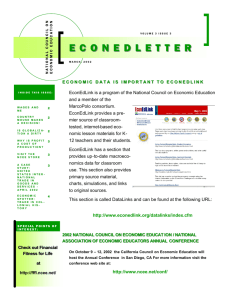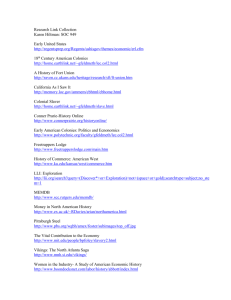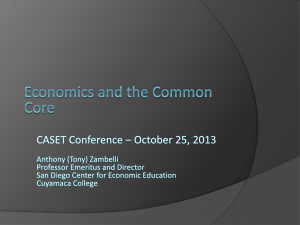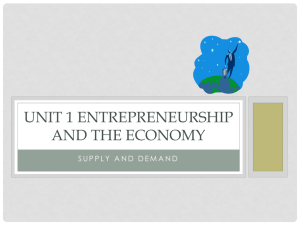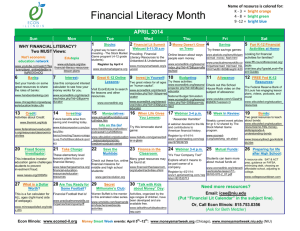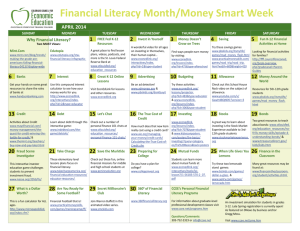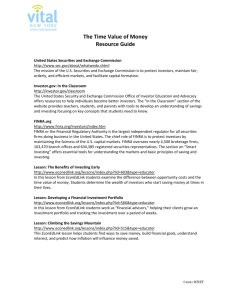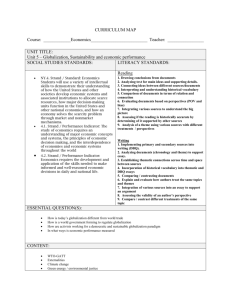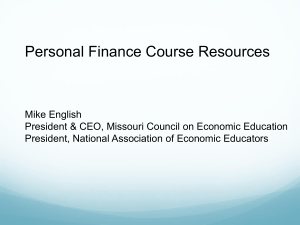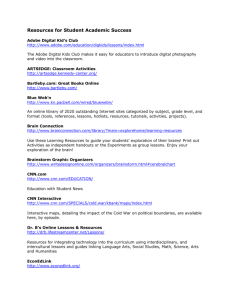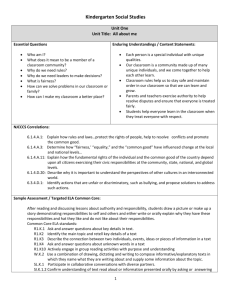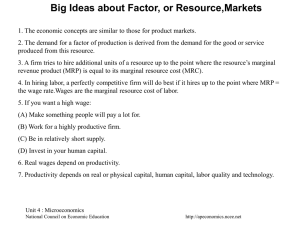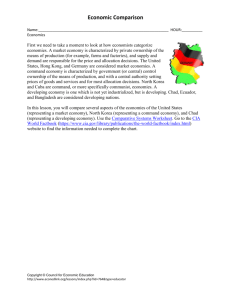econedletter - Digital Chalkboard
advertisement
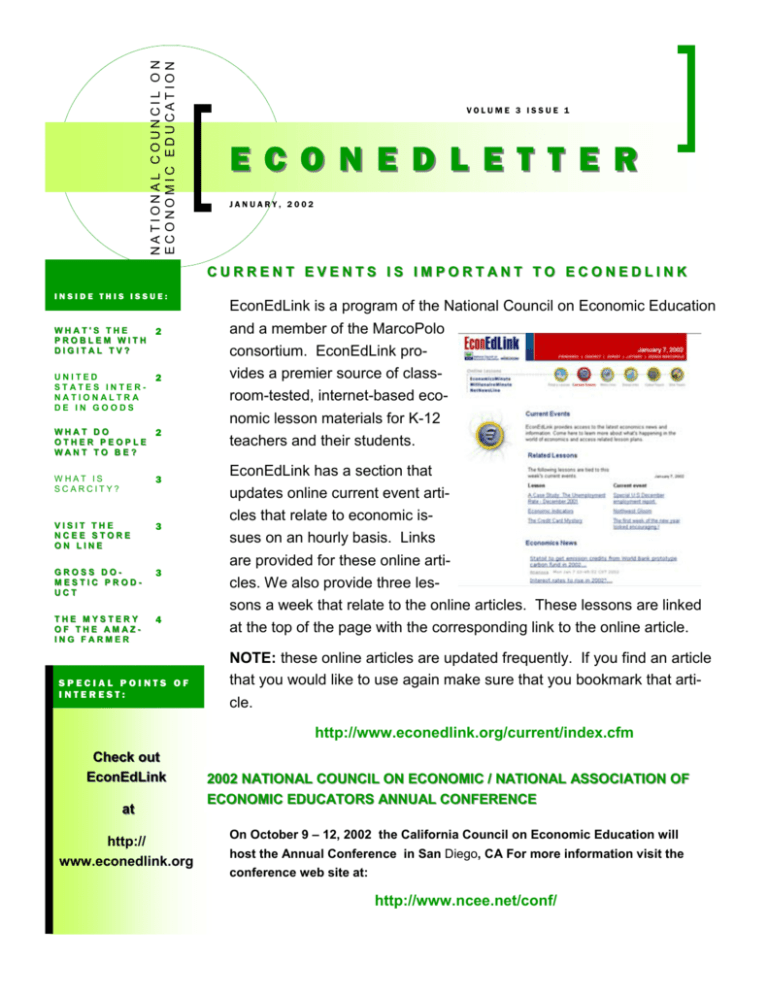
NATIONAL COUNCIL ON ECONOMIC EDUCATION VOLUME 3 ISSUE 1 E C O N E D L E T T E R JANUARY, 2002 CURRENT EVENTS IS IMPORTANT TO ECONEDLINK INSIDE THIS ISSUE: WHAT'S THE PROBLEM WITH DIGITAL TV? 2 UNITED STATES INTERNATIONALTRA DE IN GOODS 2 WHAT DO OTHER PEOPLE WANT TO BE? 2 WHAT IS SCARCITY? 3 VISIT THE NCEE STORE ON LINE 3 GROSS DOMESTIC PRODUCT 3 THE MYSTERY OF THE AMAZING FARMER 4 SPECIAL POINTS OF INTEREST: EconEdLink is a program of the National Council on Economic Education and a member of the MarcoPolo consortium. EconEdLink provides a premier source of classroom-tested, internet-based economic lesson materials for K-12 teachers and their students. EconEdLink has a section that updates online current event articles that relate to economic issues on an hourly basis. Links are provided for these online articles. We also provide three lessons a week that relate to the online articles. These lessons are linked at the top of the page with the corresponding link to the online article. NOTE: these online articles are updated frequently. If you find an article that you would like to use again make sure that you bookmark that article. http://www.econedlink.org/current/index.cfm Check out EconEdLink at http:// www.econedlink.org 2002 NATIONAL COUNCIL ON ECONOMIC / NATIONAL ASSOCIATION OF ECONOMIC EDUCATORS ANNUAL CONFERENCE On October 9 – 12, 2002 the California Council on Economic Education will host the Annual Conference in San Diego, CA For more information visit the conference web site at: http://www.ncee.net/conf/ VOLUME 3 ISSUE 1 Page 2 WHAT'S THE PROBLEM WITH DIGITAL TV The Federal Communications Commission has mandated that by the year 2006 all TV transmission will be digital. Most homes in the United States have more than one television set and most of those sets are analog not digital, Analog TVs are not capable of receiving digital transmission. http://www.econedlink.org/lessons/index.cfm?lesson=EM203 A CASE STUDY: UNITED STATES INTERNATIONAL TRADE IN GOODS AND SERVICES - DECEMBER 2001 Announcement The U.S. international trade deficit in goods and services increased by $10.4 billion to $29.4 billion in October from $19.0 billion in September as imports increased ($11.0 b) more than exports ($0.5 b). The purpose of the international trade case study is to provide the most recent data on international trade, interpretations of trends and causes of changes in trade deficits and surpluses, and a number of relevant student and classroom activities. http://www.econedlink.org/lessons/index.cfm?lesson=EM224 WHAT DO OTHER PEOPLE WANT TO BE? In this lesson, students will graph people's job choices and identify what goods and services each job provides. The graphing in this lesson is simple graphing done via interactive activities and assumes that students are familiar with the concept of graphing. An explanation of graphing is available for teachers to paraphrase at the following website if necessary. This lesson follows the What Do You Want to Be? lesson and builds on some of the decisions students made in that lesson, although it can also stand alone. http://www.econedlink.org/lessons/index.cfm?lesson=EM212 Check out the NEW lessons posted on EconEdLink VOLUME 3 ISSUE 1 Page 3 FREQUENTLY ASKED ECONOMIC QUESTIONS Q. Doesn't scarcity simply mean that a good is in short supply? A. Scarcity in economic terms is a little more complicated. Scarcity results because natural resources, human resources and capital resources are not available in sufficient quantity to satisfy all wants for them. In other words resources are limited and wants are unlimited. Only "free goods" like air are in most cases not scarce. For example, with production choices come decisions concerning what to produce from a particular natural resource. If the choice is made to produce paper for textbooks from a stand of trees, then no other product can be produced from that particular stand of timber. Yet, many other products are desired. Thus an opportunity cost decision must be made. That means that the next best alternative good cannot be produced. Therefore economic resources are scarce. By : Lynn Huselton Plano East Senior High Plano, TX VISIT THE NCEE STORE ON LINE The NCEE Store contains the same great publications that you'll find in our catalog as well as additional information on each of the publications. http://store.ncee.net/ A CASE STUDY: GROSS DOMESTIC PRODUCT DECEMBER 2001 Doesn't scarcity simply mean that a good is in short Announcement Real Gross Domestic Product (GDP) during the third quarter (July through September) of 2001 decreased at an annual rate of 1.3 percent. This is the "final" estimate for the third quarter and is based on more complete source data than the previous two estimates. (This estimate is a slightly greater decrease than reported in the estimate one month ago.) During the first and second quarters of 2001, real GDP increased at an annual rate of 1.3 percent and 0.3 percent respectively. In this lesson you and your students will explore the impact the gross domestic product has on our society both nationally and internationally. http://www.econedlink.org/lessons/index.cfm?lesson=EM225 supply? WE are on the web! http://www.ncee.net We are a unique nonprofit partnership of leaders in education, business and labor devoted to helping youngsters learn to think, to choose and to function in a changing global economy. NATIONAL COUNCIL ON ECONOMIC EDUCATION We were founded in 1949, and today we are the premier source of teacher training and materials used to instill an understanding of economic principles for grades kindergarten through twelve. 215 N. 8th Street Suite 215 Lincoln, NE 68508 Phone: 402-438-6929 Fax: 402-438-6867 We are a nationwide network of state councils and over 260 university-based centers called EconomicsAmerica. Email: jlefeber@ncee.net E C O N O M I C E D U C A T I O N We are also an international economics training initiative called EconomicsInternational, which carries our market principles to the world. Through this vital network we carry out our mission with vigor, integrity and demonstrated success. THE MYSTERY OF THE AM AZING FARMER The numbers show a big change in the agricultural workforce. 200 years ago, 90% of the population farmed. Today less than 3% of the population farms. What might explain this change? How can so few farmers produce enough food and fiber for so many people . http://www.econedlink.org/lessons/index.cfm?lesson=EM206
